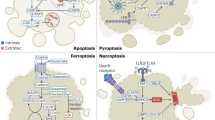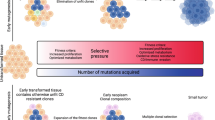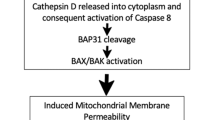Abstract
Cell death is a normal facet of human physiology, ensuring tissue homeostasis by offsetting cell production with cell demise. Neoplasms arise in part because of defects in physiological cell death mechanisms, contributing to pathological cell expansion. Defects in normal cell death pathways also contribute to cancer progression by permitting progressively aberrant cell behaviors, while also desensitizing tumor cells to immune-mediated attack, radiation, and chemotherapy. Through basic research, much has been learned about the molecular mechanisms responsible for cell turnover and how tumors escape cell death. By exploiting this knowledge base, several innovative strategies for eradicating malignancies have materialized that are based on restoration of natural pathways for cell autodestruction. Some of these strategies have advanced into human clinical trials. Several of the current strategies based on targeting core components of the cell death machinery for cancer therapy are reviewed here, and a summary of progress toward clinical applications is provided.
Key Points
-
Drugs that restore apoptosis sensitivity to cancer cells are promising candidates for a new generation of anticancer therapy
-
Antiapoptotic Bcl-2-family proteins block a mitochondrial pathway for cell death that is largely responsible for the cytotoxic activity of conventional anticancer drugs
-
Clinical trials of a DNA-based drug targeting Bcl-2 show evidence of bioactivity against several types of chemorefractory cancer
-
TRAIL is a cytokine that selectively induces apoptosis of cancer cells, often bypassing roadblocks to apoptosis found in chemorefractory tumors
-
Agonistic antibodies that bind and activate TRAIL receptors appear to be safe in humans, and represent one of the possibilities for activating the same apoptosis pathway that is often employed by immune cells for attacking tumors
-
IAP-family proteins block distal steps in apoptosis pathways; compounds that neutralize IAPs show promising preclinical activity, and DNA-based drugs targeting IAPs are undergoing testing in early-stage human clinical trials
This is a preview of subscription content, access via your institution
Access options
Subscribe to this journal
Receive 12 print issues and online access
$209.00 per year
only $17.42 per issue
Buy this article
- Purchase on Springer Link
- Instant access to full article PDF
Prices may be subject to local taxes which are calculated during checkout

Similar content being viewed by others
References
Hanahan D and Weinberg RA (2000) The hallmarks of cancer. Cell 100: 57–70
Green DR and Evan G (2002) A matter of life and death. Cancer Cell 1: 19–30
Danial NN and Korsmeyer SJ (2004) Cell death: critical control points. Cell 116: 205–219
Levine B (2005) Eating oneself and uninvited guests: autophagy-related pathways in cellular defense. Cell 120: 159–162
Reed JC (2003) Apoptosis-targeted therapies for cancer. Cancer Cell 3: 17–22
Reed JC and Pellecchia M (2005) Apoptosis-based therapies for hematological malignancies. Blood 106: 408–418
Arafat WO et al. (2003) An adenovirus encoding proapoptotic Bax synergistically radiosensitizes malignant glioma. Int J Radiat Oncol Biol Phys 55: 1037–1050
Koga S et al. (2000) A novel telomerase-specific gene therapy: gene transfer of caspase-8 utilizing the human telomerase catalytic subunit gene promoter. Hum Gene Ther 11: 1397–1406
Salvesen GS (2002) Caspases and apoptosis. Essays Biochem 38: 9–19
Reed JC et al. (2004) The domains of apoptosis: a genomics perspective. Sci STKE 2004: re9
Boatright KM and Salvesen GS (2003) Mechanisms of caspase activation. Curr Opin Cell Biol 15: 725–731
Deveraux QL and Reed JC (1999) IAP family proteins: suppressors of apoptosis. Genes Dev 13: 239–252
Salvesen GS and Duckett CS (2002) IAP proteins: blocking the road to death's door. Nat Rev Mol Cell Biol 3: 401–410
Jesenberger V and Jentsch S (2002) Deadly encounter: ubiquitin meets apoptosis. Nat Rev Mol Cell Biol 3: 112–121
Thome M and Tschopp J (2001) Regulation of lymphocyte proliferation and death by FLIP. Nat Rev Immunol 1: 50–58
Hyer ML et al.: The FLIP-side of Fas (CD95) signaling. Clin Cancer Res, in press
Pathan N et al. (2001) TUCAN: An anti-apoptotic caspase-associated recruitment domain family protein over-expressed in cancer. J Biol Chem 276: 32220–32229
Kroemer G and Reed JC (2000) Mitochondrial control of cell death. Nat Med 6: 513–519
Evan GI and Vousden KH (2001) Proliferation, cell cycle and apoptosis in cancer. Nature 411: 342–348
Spierings D et al. (2005) Connected to death: the (unexpurgated) mitochondrial pathway of apoptosis. Science 310: 66–67
Green DR and Kroemer G (2004) The pathophysiology of mitochondrial cell death. Science 305: 626–629
Cory S et al. (2003) The Bcl-2 family: roles in cell survival and oncogenesis. Oncogene 22: 8590–8607
Strasser A (2005) The role of BH3-only proteins in the immune system. Nat Rev Immunol 5: 189–200
Willis SN and Adams JM (2005) Life in the balance: how BH3-only proteins induce apoptosis. Curr Opin Cell Biol 17: 617–625
Fesik SW (2000) Insights into programmed cell death through structural biology. Cell 103: 273–282
Pattingre S et al. (2005) Bcl-2 antiapoptotic proteins inhibit Beclin 1-dependent autophagy. Cell 122: 927–939
Shimizu S et al. (2004) Role of Bcl-2 family proteins in a non-apoptotic programmed cell death dependent on autophagy genes. Nat Cell Biol 6: 1221–1228
Yue Z et al. (2003) Beclin 1, an autophagy gene essential for early embryonic development, is a haploinsufficient tumor suppressor. Proc Natl Acad Sci USA 100: 15077–15082
Pratt MAC et al. (1998) Estrogen withdrawal-induced human breast cancer tumour regression in nude mice is prevented by Bcl-2. FEBS Lett 440: 403–408
Pfahl M and Piedrafita FJ (2003) Retinoid targets for apoptosis induction. Oncogene 22: 9058–9062
Guzey M et al. (2002) Apoptosis induction by 1alpha225-dihydroxyvitamin-D3 in prostate cancer. Mol Cancer Ther 1: 667–677
Duan H et al. (2005) Histone deacetylase inhibitors down-regulate bcl-2 expression and induce apoptosis in t(14;18) lymphomas. Mol Cell Biol 25: 1608–1619
Dean NM and Bennett CF (2003) Antisense oligonucleotide-based therapeutics for cancer. Oncogene 22: 9087–9096
Klasa RJ et al. (2002) Oblimersen Bcl-2 antisense: facilitating apoptosis in anticancer treatment. Antisense Nucleic Acid Drug Dev 12: 193–213
Weeratna RD et al. (2005) TLR agonists as vaccine adjuvants: comparison of CpG ODN and Resiquimod (R-848). Vaccine 23: 5263–5270
Pellecchia M and Reed JC (2004) Inhibition of anti-apoptotic Bcl-2 family proteins by natural polyphenols: new avenues for cancer chemoprevention. Curr Pharm Des 10: 1387–1398
Kitada S et al. (2003) Discovery, characterization and structure-activity relationships studies of pro-apoptotic polyphenols targeting B-cell lymphocyte/leukemia-2 proteins. J Med Chem 46: 4259–4264
Leone M et al. (2003) Cancer prevention by tea polyphenols is linked to their direct inhibition of anti-apoptotic Bcl-2-family proteins. Cancer Res 63: 8118–8121
Chan SL et al. (2003) Identification of chelerythrine as an inhibitor of BclXL function. J Biol Chem 278: 20453–20456
Tzung S et al. (2001) Antimycin A mimics a cell-death-inducing Bcl-2 homology domain 3. Nat Cell Biol 3: 183–191
Flack MR et al. (1993) Oral gossypol in the treatment of metastatic adrenal cancer. J Clin Endocrinol Metab 76: 1019–1024
Van Poznak C et al. (2001) Oral gossypol in the treatment of patients with refractory metastatic breast cancer: a phase I/II clinical trial. Breast Cancer Res Treat 66: 239–248
Becattini B et al. (2004) Rational design and real time in-cell detection of the pro-apoptotic activity of a novel compound targeting Bcl-XL. Chem Biol 11: 389–395
Oltersdorf T et al. (2005) An inhibitor of Bcl-2-family proteins induces regression of solid tumors. Nature 435: 677–681
Zhai D et al. (2006) Comparison of chemical inhibitors of antiapoptotic Bcl-2-family proteins. Cell Death Differ 28 April [Epub ahead of print; doi: 10.1038/sj.cdd.4401937]
Wallach D et al. (1999) Tumor necrosis factor receptor and Fas signaling mechanisms. Ann Rev Immunol 17: 331–367
Ashkenazi A (2002) Targeting death and decoy receptors of the tumour-necrosis factor superfamily. Nat Rev Cancer 2: 420–430
Peter ME (2005) Taming TRAIL: the winding path to a novel form of cancer therapy. Cell Death Differ 12: 693–694
Eggermont AM and ten Hagen TL (2003) Tumor necrosis factor-based isolated limb perfusion for soft tissue sarcoma and melanoma: ten years of successful antivascular therapy. Curr Oncol Rep 5: 79–80
Luo JL et al. (2004) Inhibition of NF-κB in cancer cells converts inflammation-induced tumor growth mediated by TNFα to TRAIL-mediated tumor regression. Cancer Cell, 6: 297–305
Karin M et al. (2002) NF-κB in cancer: from innocent bystander to major culprit. Nat Rev Cancer 2: 301–310
Le LH et al. (2004) Phase 1 study of a fully human monoclonal antibody to the tumor necrosis factor-related apoptosis-inducing ligand death receptor 4 (TRAIL-R1) in subjects with advanced solid malignancies or non-Hodgkin's lymphoma (NHL). J Clin Oncol 22 (14S): 2533
Ichikawa K et al. (2001) Tumoricidal activity in the absence of hepatocyte cytoxicity of a novel anti-human DR5 monoclonal antibody. Nat Med 7: 954–960
LeBlanc H et al. (2002) Tumor-cell resistance to death receptor-induced apoptosis through mutational inactivation of the proapoptotic Bcl-2 homolog Bax. Nat Med 8: 274–281
Kim Y et al. (2002) An inducible pathway for degradation of FLIP protein sensitizes tumor cells to TRAIL-induced apoptosis. J Biol Chem 277: 22320–22329
Singh TR et al. (2005) HDAC inhibitors enhance the apoptosis-inducing potential of TRAIL in breast carcinoma. Oncogene 24: 4609–4623
Watanabe YH et al. (2005) ATP binding to nucleotide binding domain (NBD)1 of the ClpB chaperone induces motion of the long-coiled coil, stabilizes the hexamer, and activates NBD2. J Biol Chem 280: 24562–24567
Inoue S et al. (2004) Histone deacetylase inhibitors potentiate TNF-related apoptosis-inducing ligand (TRAIL)-induced apoptosis in lymphoid malignancies. Cell Death Differ 11 (Suppl 2): S193–S206
Aron JL et al. (2002) Depsipeptide (FR901228) induces histone acetylation and inhibition of histone deacetylase in chronic lymphocytic leukemia cells concurrent with activation of caspase-8 mediated apoptosis and down regulation of c-FLIP protein. Blood 102: 652–658
Suh N et al. (1999) A novel synthetic oleanane triterpenoid, 2-cyano-3,12-dioxoolean-1,9-dien-28-oic acid, with potent differentiating, antiproliferative, and anti-inflammatory activity. Cancer Res 59: 336–341
Ikeda T et al. (2004) Induction of redox imbalance and apoptosis in multiple myeloma cells by the novel triterpenoid 2-cyano-3,12-dioxoolean-1,9-dien-28-oic acid. Mol Cancer Ther 3: 39–45
Hyer ML et al. (2005) Synthetic triterpenoids cooperate with TRAIL to induce apoptosis of breast cancer cells. Cancer Res 65: 4799–4808
Pedersen IM et al. (2002) The triterpenoid CDDO induces apoptosis in refractory CLL B-cells. Blood 100: 2965–2972
Suh W-S et al. (2003) Synthetic triterpenoids activate a pathway for apoptosis in AML cells involving down-regulation of FLIP and sensitization to TRAIL. Leukemia 17: 2122–2129
Altucci L et al. (2001) Retinoic acid-induced apoptosis in leukemia cells is mediated by paracrine action of tumor-selective death ligand TRAIL. Nature Med 7: 680–686
Cartee L et al. (2003) Protein kinase C-dependent activation of the tumor necrosis factor receptor-mediated extrinsic cell death pathway underlies enhanced apoptosis in human myeloid leukemia cells exposed to bryostatin 1 and flavopiridol. Mol Cancer Ther 2: 83–93
Altieri DC (2003) Blocking survivin to kill cancer cells. Methods Mol Biol 223: 533–542
Chen J et al. (2000) Down-regulation of survivin by antisense oligonucleotides increases apoptosis, inhibits cytokinesis and anchorage-independent growth. Neoplasia 2: 235–241
Cummings J et al. (2005) Validation of pharmacodynamic assays to evaluate the clinical efficacy of an antisense compound (AEG 35156) targeted to the X-linked inhibitor of apoptosis protein XIAP. Br J Cancer 92: 532–538
Fesik SW and Shi Y (2001) Structural biology. Controlling the caspases. Science 294: 1477–1478
Shi Y (2002) A conserved tetrapeptide motif: potentiating apoptosis through IAP-binding. Cell Death Differ 9: 93–95
Li L et al. (2004) A small molecule Smac mimic potentiates TRAIL- and TNFalpha-mediated cell death. Science 305: 1471–1474
Oost TK et al. (2004) Discovery of potent antagonists of the antiapoptotic protein XIAP for the treatment of cancer. J Med Chem 47: 4417–4426
Franklin MC et al. (2003) Structure and function analysis of peptide antagonists of melanoma inhibitor of apoptosis (ML-IAP). Biochemistry 42: 8223–8231
Park CM et al. (2005) Non-peptidic small molecule inhibitors of XIAP. Bioorg Med Chem Lett 15: 771–775
Schimmer AD et al. (2004) Small-molecule antagonists of apoptosis-suppressor XIAP exhibit broad anti-tumor activity. Cancer Cell 5: 25–35
Wu TY et al. (2003) Development and characterization of nonpeptidic small molecule inhibitors of the XIAP/caspase-3 interaction. Chem Biol 10: 759–767
Carter BZ et al. (2005) Small-molecule XIAP inhibitors derepress downstream effector caspases and induce apoptosis of acute myeloid leukemia cells. Blood 105: 4043–4050
Soengas MS et al. (2001) Inactivation of the apoptosis effector Apaf-1 in malignant melanoma. Nature 409: 207–211
Vassilev LT (2004) Small-molecule antagonists of p53-MDM2 binding: research tools and potential therapeutics. Cell Cycle 3: 419–421
Mitsiades CS et al. (2004) The Akt pathway: molecular targets for anti-cancer drug development. Curr Cancer Drug Targets 4: 235–256
Author information
Authors and Affiliations
Ethics declarations
Competing interests
JC Reed is the inventor of Genasense and is entitled to receive royalty payments if drug sales are initiated.
Rights and permissions
About this article
Cite this article
Reed, J. Drug Insight: cancer therapy strategies based on restoration of endogenous cell death mechanisms. Nat Rev Clin Oncol 3, 388–398 (2006). https://doi.org/10.1038/ncponc0538
Received:
Accepted:
Issue Date:
DOI: https://doi.org/10.1038/ncponc0538
This article is cited by
-
Radiosynthesis and in vivo evaluation of [125I]2-(4-iodophenethyl)-2-methylmalonic acid as a potential radiotracer for detection of apoptosis
Journal of Radioanalytical and Nuclear Chemistry (2016)
-
Promising Role of Melatonin as Neuroprotectant in Neurodegenerative Pathology
Molecular Neurobiology (2015)
-
Docetaxel in combination with octreotide shows synergistic apoptotic effect by increasing SSTR2 and SSTR5 expression levels in prostate and breast cancer cell lines
Cancer Chemotherapy and Pharmacology (2015)
-
Radiation with immunotherapy: an emerging combination for cancer treatment
Journal of Radiation Oncology (2015)
-
Essential versus accessory aspects of cell death: recommendations of the NCCD 2015
Cell Death & Differentiation (2015)



